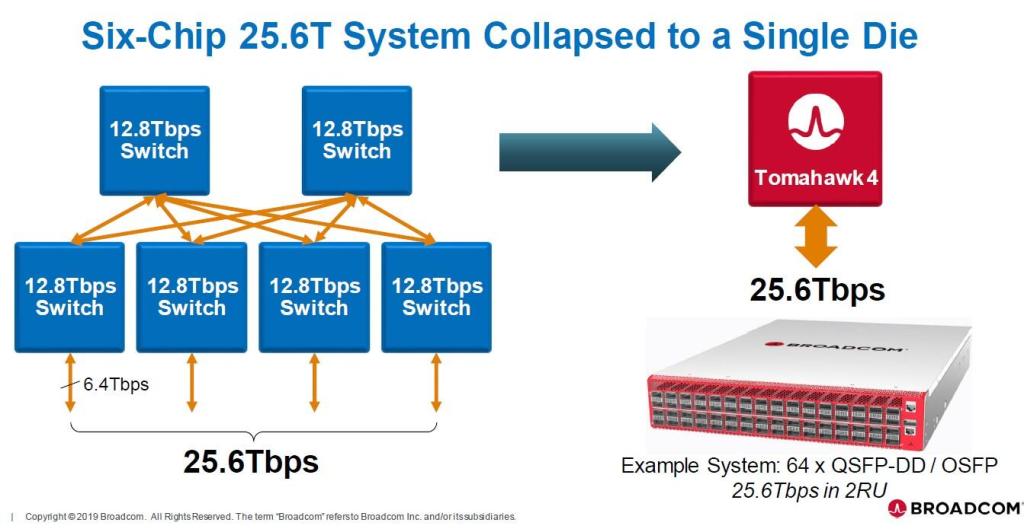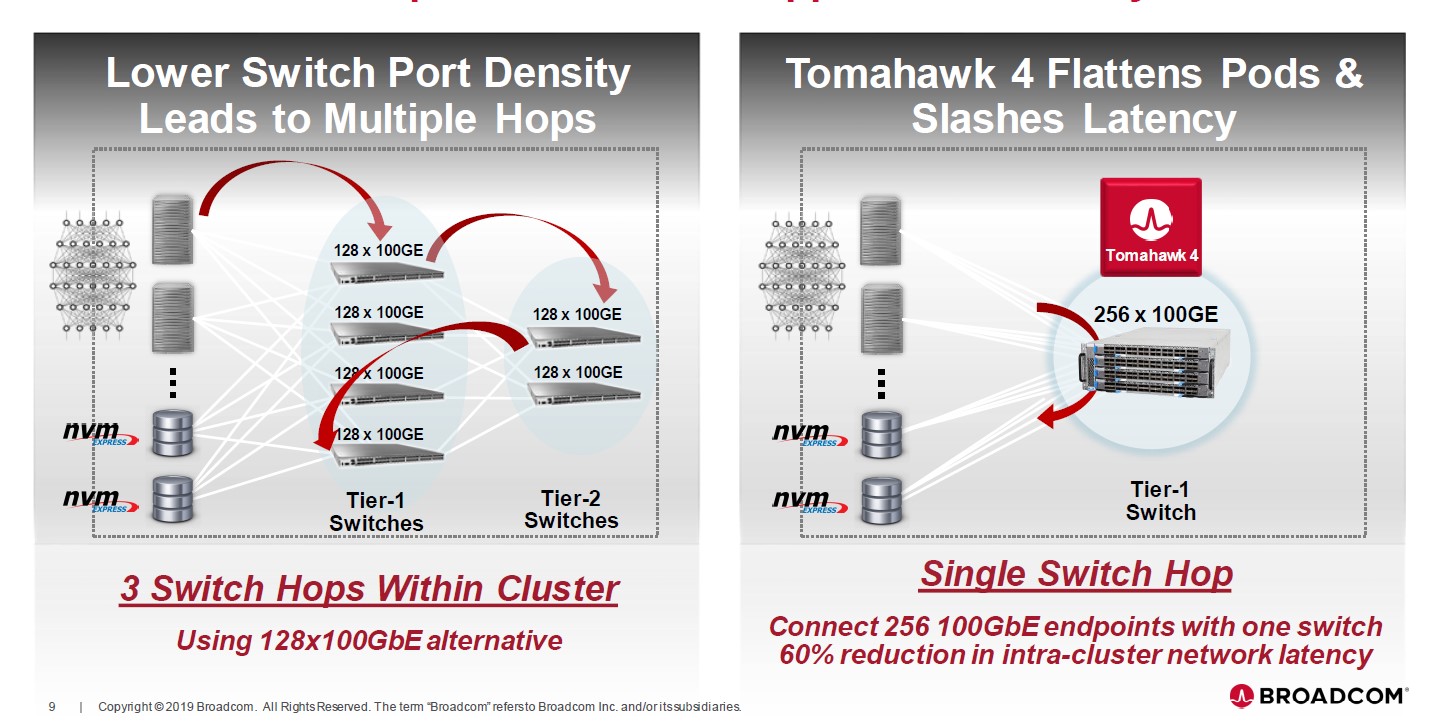Broadcom Ships Tomahawk 4 for Hyperscale Networks
Article By : Nitin Dahad

The monolithic chip delivers 64 ports of 400GbE switching and routing for hyperscale networks.
As demands for machine learning grow, so does the need for speed, especially for the big hyperscaler companies as they address their own rapid expansion into almost every industry vertical. To meet this requirement, Broadcom has launched what it claims is the highest bandwidth Ethernet switch chip, demonstrating 25.6 terabits/sec switching in a single monolithic device.
Built by TSMC in a 7nm process, the new 31-billion transistor Tomahawk 4 chip delivers up to 64 ports of 400GbE switching and routing for high-throughput, low latency hyperscale networks, at 75 percent lower power and cost compared to alternative solutions, according to Broadcom. It also offers the highest radix of 100GbE ports: 256 ports supported on a single chip, enabling low-latency, single-hop networks for massive alternative compute clusters.
Connectivity density is enabled using 512 instances of the high performance 50G PAM4 SerDes cores, enabling long-reach East-West optical links and direct-attached-copper in-rack cabling in the data center.

Significantly reduced latency is one of the key features of the single chip approach of the Tomahawk 4 chip, right. (Source: Broadcom)
The Tomahawk 4 chip also features what Broadcom said is the industry’s most advanced 25.6Tbps shared-buffer architecture, offering up to five times higher incast absorption and providing the highest performance and lowest end-to-end latency for RoCEv2 workloads. In addition, it adds new advanced load balancing mechanisms, virtually eliminating hash polarization and providing extremely efficient, controllable link utilization; and advanced congestion management, enabling new traffic management paradigms.
The company said the 25.6Tbps performance is double the throughput of any other silicon available today and offers massive I/O density plus advanced in-band or streaming instrumentation, using four 1GHx Arm processors. Broadcom’s product line manager Pete Del Vechio told EE Times that the company’s roadmap for its switch chip is doubling in speed every two years – the Tomahawk 4 has been delivered in less than two years after the previous 12.8Tbps product generation, and now offers with 512 50G PAM4 SerDes. He added that he sees no slowdown in this performance trajectory for future generations.
Addressing hyperscale cloud network bandwidth demand
The Tomahawk 4 addresses the unrelenting growth of hyperscale cloud networks, with bandwidth increasing by 25 percent and storage by 36 percent year-over-year, according to Cisco. Workloads for deep learning, using massively distributed neural networks and alternative computing nodes, require a dramatic increase in bandwidth with dense 100/200/400GbE links spanning high-radix, ultra-low-latency network topologies.
The continued trend towards disaggregated, high-density flash storage is concurrently demanding step functions in network throughput and reduced end-to-end access times. With its switching performance, high 100/200/400GbE port density, and feature set optimized for cloud use cases, Broadcom said its Tomahawk 4 chip is ideal for backbone applications in next generation hyperscale data center networks, enabling the adoption of 100/200/400GbE Ethernet solutions at a point where optics utilizing 50G PAM4 connectivity are shipping in high volumes.
The Linley Group’s principal analyst, Bob Wheeler, said, “Tomahawk 4 is an engineering tour de force, packing an unprecedented number of serdes into a monolithic 7nm chip. As a result, Broadcom is once again first in delivering the next switch density, which hyperscalers need as they deploy 400G Ethernet.”
Del Vechio told us that the advanced instrumentation incorporated on chip within the packet processing pipeline is a significant feature, utilizing four 1 GHz ARM processors for high-bandwidth, fully programmable streaming telemetry and sophisticated embedded applications such as on-chip statistics summarization. It includes IFA 2.0 for inband telemetry, postcards for out-of-band telemetry, SerDes link quality meters, and visibility into all on-chip packet drops and congestion events.
In addition to its chip, Broadcom also said it is now opening up its switch API as open source software, with the introduction of Broadcom Open Network Switch APIs (OpenNSA), opening its SDK APIs for StrataXGS and StrataDNX products. Multiple open source network operating system initiatives are underway in the disaggregation ecosystem, focused on hyperscale and service provider markets. OpenNSA enables these initiatives on merchant silicon and allows the larger community to build on top of these efforts. OpenNSA also expands open compute project efforts, like switch abstraction interface (SAI), by simplifying the process of translating SAI APIs to Broadcom SDK APIs.
With the launch of its Tomahawk 4 chip, Broadcom said a number of its key customers are already sampling the device, including Alibaba Cloud, Google Cloud, Microsoft, Tencent and Uber. Yiqun Cai, vice president of network, Alibaba Cloud Intelligence, said that it had worked closely with Broadcom on Tomahawk 4 products, which is accelerating its ability to adopt 100/200/400GbE Ethernet solutions.
Yuval Bachar, principal hardware architect for Azure Platforms at Microsoft, said “With the exponential growth of network capacities and high-volume deployments of 100G and 400G the 25.6T Tomahawk 4 will be a major building block for that evolution. The enhanced forwarding, load balancing, buffering, and congestion control capabilities will address essential needs for hyperscale workloads and will enable the next generation of platforms and networks to be built.”
Jason Black, head of global network infrastructure at Uber also commented, “Broadcom’s StrataXGS Tomahawk product line has been a key technology component in our worldwide data center design. With the arrival of Tomahawk 4 25.6Tbps, it ushers in the era of 400GbE leaf-spine CLOS deployment, and enables Uber to support ever-increasing workloads for autonomous vehicle, SaaS, and big data applications.”